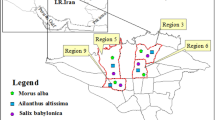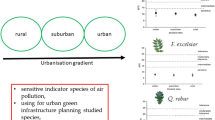Abstract
Multivariate statistical techniques were employed on twelve leaf traits in four selected common tree species (Mangifera indica L., Polyalthia longifolia Sonn., Ficus benghalensis L. and Psidium guajava L.) to evaluate their responses with respect to major air pollutants in an urban area. Discriminant analysis (DA) identified chlorophyll/carotenoid ratio, leaf dry matter content, carotenoids, net water content and ascorbic acid as the major discriminating leaf traits, which varied maximally with respect to the pollution status. Pollution response score (PRS), calculated on the basis of discriminate functional coefficient values, increased with an increase in air pollution variables for all the tested species, with the highest increase in P. longifolia and the lowest in F. benghalensis. The study highlights the usefulness of DA for evaluation of plant specific traits and PRS for selection of tolerant species.




Similar content being viewed by others
References
Awan MA, Ahmed SA, Aslam MR, Qazi IA (2011) Determination of total suspended particulate matter and heavy metals in ambient air of four cities of Pakistan. IJEE 2:128–132
CPCB (1994) Central Pollution Control Board. National ambient air quality standards notification. http://envfor.nic.in/legis/air/gsr384%28e%29.htm. Accessed 1 April 2015
CPCB (2009) Central Pollution Control Board. National ambient air quality standards. http://cpcb.nic.in/National_Ambient_Air_Quality_Standards.php. Accessed 9 April 2015
Ghude SD, Fadnavis S, Beig G, Polade SD et al (2008) Detection of surface emission hot spots, trends, and seasonal cycle from satellite-retrieved NO2 over India. Geophys Res Lett 33:D20305
Goyal P, Sidhartha (2002) Effect of winds on SO2 and SPM concentrations in Delhi. Atmos Environ 36:2925–2930
Gupta I, Kumar R (2006) Trends of particulate matter in four cities in India. Atmos Environ 40:2552–2566
Kaushik CP, Ravindra K, Yadav K, Mehta S, Haritash AK (2006) Assessment of ambient air quality in urban centres of Haryana (India) in relation to different anthropogenic activities and health risks. Environ Monit Assess 122:27–40
Merrymann EL, Spicer CW, Levy A (1973) Evaluation of arsenite modified Jacobs Hochheiser procedure. Environ Sci Technol 7:1056–1059
Mishra AK, Agrawal SB (2015) Biochemical and physiological characteristics of tropical mung bean (Vigna radiate L.) cultivars against chronic ozone stress: an insight to cultivar-specific response. Protoplasma 252(3):797–811
Mittler R (2002) Oxidative stress, antioxidants and stress tolerance. Trends Plant Sci 7:405–410
Nowak DJ, Hirabayashi S, Bodine A, Greenfield E (2014) Tree and forest effects on air quality and human health in the United States. Environ Pollut 193:119–129
Rao MN, Rao HVN (1989) Air pollution. Tata McGraw-Hill Publishing Company Limited, New Delhi
Sharma RD, Jain S, Singh K (2011) Growth rate of motor vehicles in India—impact of demographic and economic development. J Econ Soc Stud 1:137–150
Singh A (1977) Practical plant physiology. Kalyani Publishers, New Delhi
Thawale PR, Babu SS, Wakodw RR, Singh SK, Kumar S, Juwarkar AA (2011) Biochemical changes in plant leaves as a biomarker of pollution due to anthropogenic activity. Environ Monit Assess 177:527–535
Tripathi AK, Gautam M (2007) Biochemical parameters of plants as indicators of air pollution. J Environ Biol 28(1):127–132
West PW, Gaeke GC (1956) Fixation of sulfur dioxide as sulfitomercurate (II) and subsequent colorimetric estimation. Anal Chem 28:1816–1819
Wuytack T, Samson R, Wuyts K, Adriaenssens S, Kardel F, Verheyen K (2013) Do leaf characteristics of white willow (Salix alba L.), northern red oak (Quercus rubra L.), and Scots pine (Pinus sylvestris L.) respond differently to ambient air pollution and other environmental stressors? Water Air Soil Pollut 224:1635
Acknowledgments
The authors are thankful to the Head, Department of Botany, Banaras Hindu University for laboratory and central facilities. Arideep Mukherjee is thankful to Department of Science and Technology (DST) for providing financial support in the form of an Inspire fellowship. The authors are also grateful to an anonymous reviewer and senior editor for their valuable suggestions for improving the quality of the manuscript.
Author information
Authors and Affiliations
Corresponding author
Rights and permissions
About this article
Cite this article
Mukherjee, A., Agrawal, M. Pollution Response Score of Tree Species in Relation to Ambient Air Quality in an Urban Area. Bull Environ Contam Toxicol 96, 197–202 (2016). https://doi.org/10.1007/s00128-015-1679-1
Received:
Accepted:
Published:
Issue Date:
DOI: https://doi.org/10.1007/s00128-015-1679-1




